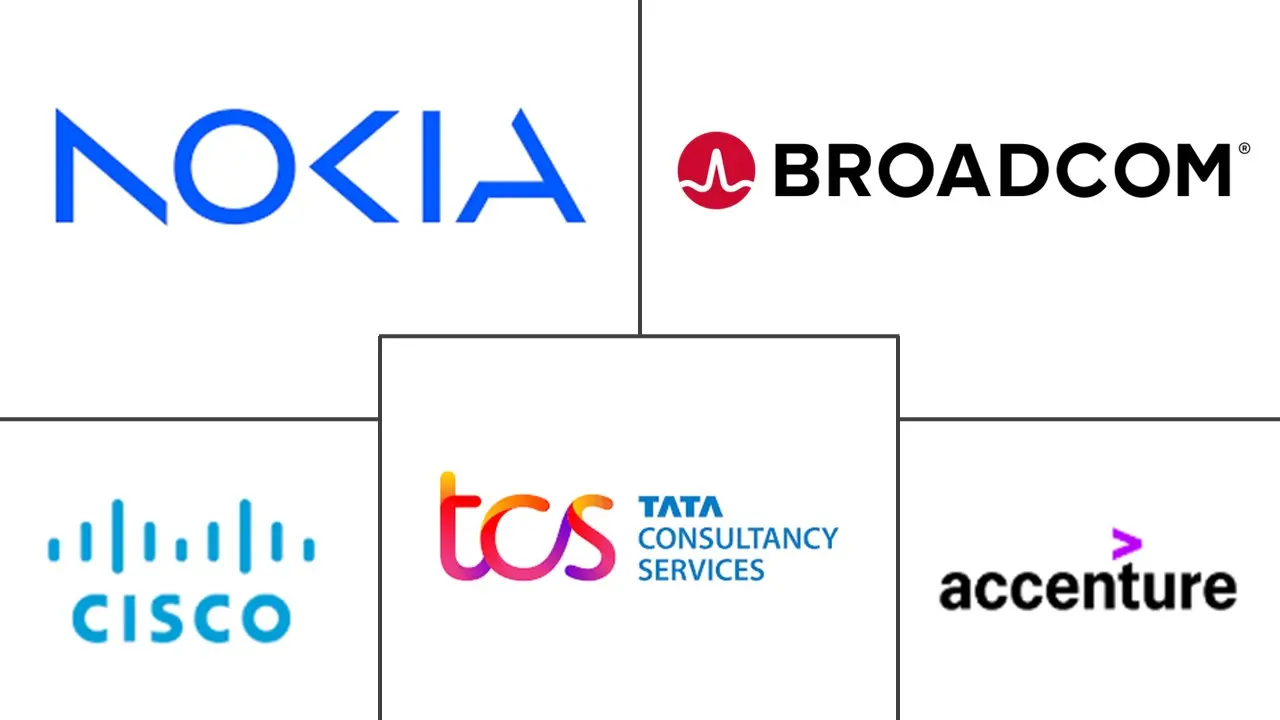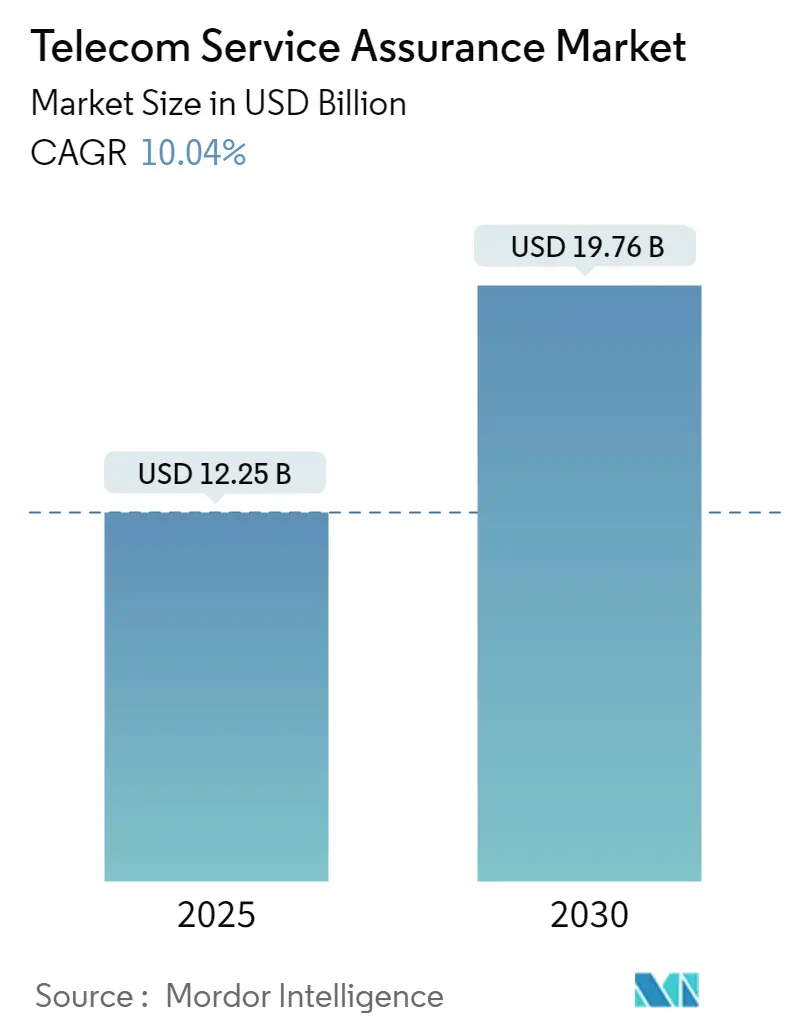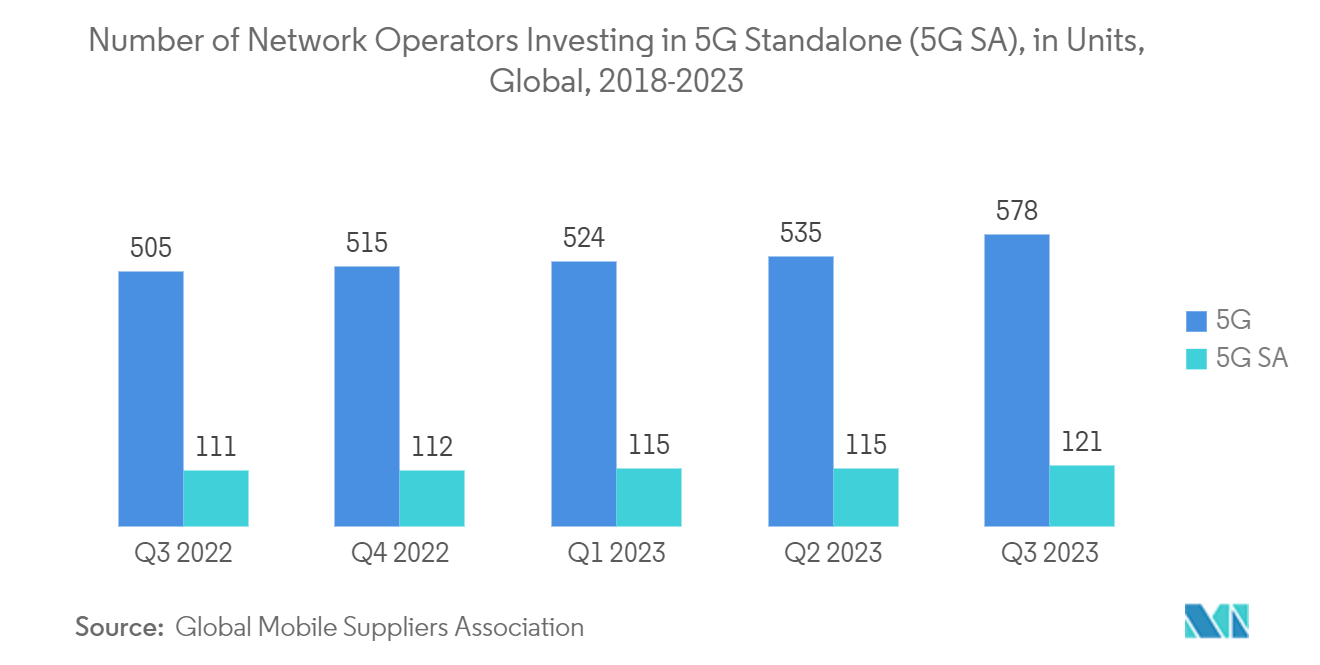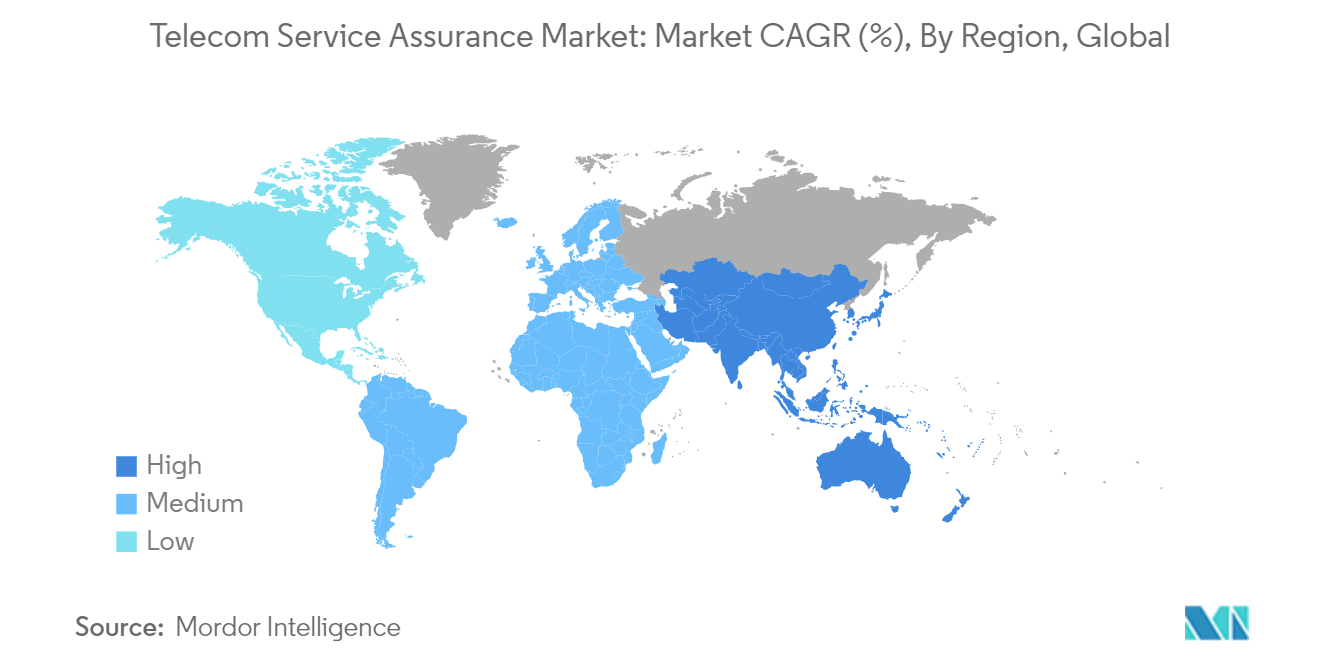Telecom Service Assurance Market Analysis
The Telecom Service Assurance Market size is estimated at USD 12.25 billion in 2025, and is expected to reach USD 19.76 billion by 2030, at a CAGR of 10.04% during the forecast period (2025-2030).
- One of the primary drivers for the global telecom service assurance market is the escalating mobile penetration worldwide. With a growing global mobile phone user base, companies increasingly use predictive modeling to analyze future growth areas and potential pitfalls.
- For instance, the ITU reported nearly 8.9 billion mobile subscriptions globally in 2023, up from 8.6 billion the previous year and surpassing the eight billion mark in 2019. This surge in smartphone adoption presents a significant growth opportunity for the telecom service assurance market.
- Telcos are in a state of flux. In the 2022 State of Customer Churn in Telecom survey, it was seen that customer loyalty to telecom providers was down to 22% post-pandemic, with customer stickiness being influenced more by the customer experience than ever. A high average churn rate plagues the telecom industry. While the broader utility market has a churn rate of about 12-15% for Western European markets, the telecommunications industry has an average churn rate of 30% to 35%. Such massive customer churn would push the telecom players to deploy service assurance solutions to improve the customer repeat rate.
- Previously, contact centers could manage telecom customer queries customers were content, and CSPs could accurately predict service assurance. However, like many others, the telecom sector faces volatility in compliance, operations, strategy, and finance. While volatility may spur innovation, especially with technological advancements, the telecom industry must navigate these shifts. Key challenges include a declining Average Return per User (ARPU) and high customer churn.
- Despite telcos' inherent value, the current economic climate has heightened consumers' price sensitivity. In response, nearly half of consumers have taken action, with 27% opting for a cheaper provider and 24% downgrading their services. This underscores telcos' need to carefully tailor their pricing strategies to meet evolving customer expectations.
Telecom Service Assurance Market Trends
Network Management System Expected to Witness Significant Growth
- Network reliability and security are paramount for seamless service delivery in today's interconnected telecom landscape. Network assurance, a critical tool for telecom companies, ensures networks operate while meeting stringent security standards.
- Network management equips CSPs with vital performance and fault information, ensuring smooth network operations. These systems swiftly collect, analyze, and distribute network events, aiding in fault resolution. Service management solutions then cross-verify this data against service guarantees and customer-specific SLAs, ensuring the desired quality of service.
- Network-based analytics play a pivotal role in meeting service assurance needs. These analytics can map application patterns across protocols and correlate them with network data paths. For instance, Cisco's network assurance engine employs formal verification techniques, leveraging data collection, network modeling, and intelligent analysis to ensure network correctness, even during reconfigurations.
- According to the Global Mobile Suppliers Association, as of the third quarter of 2023, 121 mobile network operators globally were investing in 5G standalone (5G SA) infrastructure for public networks, up from 115 the previous year. 5G SA networks do not rely on existing 4G infrastructure.
- Kentik's network observability cloud leverages a big data architecture, offering significant advantages in service assurance analytics. This architecture handles vast data volumes and enables network operations staff to swiftly navigate and explore the data, enhancing their analytics capabilities.
- Multi-site monitoring emerges as a prominent trend in network management. For instance, VMware's Telco Cloud Service Assurance allows DISH Wireless NOC to monitor and analyze data from over 20,000 cell sites. This setup enables rapid problem detection, with the NOC team promptly alerted by the VMware service, facilitating swift corrective actions and ensuring network integrity.
- Next-generation network assurance transcends mere service uptime maintenance. It proactively identifies faults, resolves issues swiftly, and optimizes network performance. In March 2024, ServiceNow deepened its collaboration with NVIDIA, focusing on delivering industry-specific GenAI for telcos. Their initial offering, Now Assist for Telecommunications Service Management (TSM), harnesses NVIDIA AI on the Now Platform, streamlining AI-driven and automated processes, especially in critical telco use cases like network management assurance.
North America Holds Significant Market Share
- Given the rapid technological progress and widespread adoption in countries such as the United States and Canada, North America is expected to experience a significant increase in the telecom service assurance market. The number of mobile cellular subscriptions has been rising exponentially over the last few years owing to technological advancements by OEMs and consumer interest in newer and more advanced handsets.
- The region is witnessing a rising demand for telecom service assurance solutions owing to the increasing adoption of 5G networks and network complexity, customers' growing need for high-quality, reliable, and consistent network services, and the growth in the number of cellular subscribers in the region.
- The growth of 5G networks in North America is a driving force for developing the market studied throughout the region. 5G offers ultra-fast speeds, significantly lower latency, and increased capacity, allowing transformative technologies like augmented reality, IoT, and autonomous vehicles. This expansion is driving demand for improvements in infrastructure and services to meet the growing number of devices and data-intensive applications.
- The development of Open RAN is expected to fuel the market's growth as it is a more complex network architecture compared to traditional, vendor-specific RAN solutions. This complexity arises from integrating components from different vendors, which requires comprehensive service assurance capabilities to monitor, manage, and optimize the entire network's performance effectively.
- The region is witnessing a continued investment of players in open radio access networks (Open RAN). For instance, in December 2023, AT&T partnered with Ericsson to lead the United States in commercial-scale open radio access network (Open RAN) deployment. The partnership may boost the telecommunications industry's efforts and help build a more robust ecosystem of network infrastructure providers and suppliers. This advanced open management approach to building the network may enable the company to continue to invest in its fast-growing broadband network.
- According to Ericsson, North America's 5G mobile subscriptions are expected to grow from 260.40 million in 2023 to 420.04 million by 2029. The rise in mobile subscriptions depicts the growing usage of networks across various applications, such as mobile banking and healthcare. Any network downtime or performance degradation may have significant consequences, highlighting the need for service assurance.
Telecom Service Assurance Industry Overview
The telecom service assurance market is highly fragmented due to the presence of both global players and small and medium-sized enterprises. Some of the major players in the market are Nokia Corporation, Broadcom Inc. (CA Technologies Inc.), Cisco Systems, Inc., Tata Consultancy Services Limited, and Accenture PLC. Players in the market are adopting strategies such as partnerships and acquisitions to enhance their product offerings and gain sustainable competitive advantage.
- In November 2023, Cisco announced a new collaboration between Cisco ThousandEyes and Amazon CloudWatch Internet Monitor (CWIM), a new Internet monitoring service from Amazon Web Services (AWS). The integration allowed customers unparalleled visibility into their cloud deployments, enabling them to deliver optimized digital experiences. The new integration demonstrated Cisco’s commitment to its network assurance vision.
- In January 2024, in collaboration with Nokia and supported by the European Union’s research funds, Telia Finland explored the software-as-a-service (SaaS) model and public cloud environments for 5G standalone (SA). This initiative, named Sirius, aims to establish a 5G-SA network equipped with a specialized 5G core and mobile edge computing (MEC) infrastructure spanning cross-border highways and seaways.
Telecom Service Assurance Market Leaders
-
Nokia Corporation
-
Broadcom Inc. (CA Technologies Inc.)
-
Cisco Systems, Inc.
-
Tata Consultancy Services Limited
-
Accenture PLC
- *Disclaimer: Major Players sorted in no particular order
Telecom Service Assurance Market News
- March 2024: ServiceNow deepened its collaboration with NVIDIA, focusing on delivering industry-specific GenAI for telcos. Their initial offering, called Now Assist for Telecommunications Service Management (TSM), harnesses NVIDIA AI on the Now Platform, streamlining AI-driven and automated processes, especially in critical telco use cases like network management assurance.
- February 2024: MYCOM OSI unveiled enhanced features for its Experience Assurance and Analytics (EAA) Service Assurance suite. These upgrades aim to expedite identifying, diagnosing, and resolving network issues on mobile and fixed lines.
Telecom Service Assurance Industry Segmentation
Telecom service assurance involves continuously monitoring, managing, and optimizing networks to ensure predefined service level agreements (SLAs), focusing on maintaining peak performance and reliability and addressing issues promptly. The scope of the study delves into service assurance solutions and service types around the globe, and market size encompasses the revenue generated from service assurance solutions and service types offered by various players operating in the market. The study tracks the key market parameters, underlying growth influencers, and major vendors operating, supporting market estimations and growth rates during the forecast period.
The market is segmented by component type (system type [probe system, network management, workforce management, fault management, quality monitoring, and other system types], services type [professional services, managed services]), deployment type (on-premise and hosted), and geography (North America, Europe, Asia-Pacific, Latin America, and the Middle East & Africa). The report offers the market size in value terms in USD for all the abovementioned segments.
| By Component Type | System Type | Probe System | |
| Network Management | |||
| Workforce Management | |||
| Fault Management | |||
| Quality Monitoring | |||
| Other System Types | |||
| Services Type | Professional Services | ||
| Managed Services | |||
| By Deployment Type | On-Premise | ||
| Hosted | |||
| By Geography*** | North America | ||
| Europe | |||
| Asia | |||
| Australia and New Zealand | |||
| Latin America | |||
| Middle East & Africa | |||
Telecom Service Assurance Market Research FAQs
How big is the Telecom Service Assurance Market?
The Telecom Service Assurance Market size is expected to reach USD 12.25 billion in 2025 and grow at a CAGR of 10.04% to reach USD 19.76 billion by 2030.
What is the current Telecom Service Assurance Market size?
In 2025, the Telecom Service Assurance Market size is expected to reach USD 12.25 billion.
Who are the key players in Telecom Service Assurance Market?
Nokia Corporation, Broadcom Inc. (CA Technologies Inc.), Cisco Systems, Inc., Tata Consultancy Services Limited and Accenture PLC are the major companies operating in the Telecom Service Assurance Market.
Which is the fastest growing region in Telecom Service Assurance Market?
North America is estimated to grow at the highest CAGR over the forecast period (2025-2030).
Which region has the biggest share in Telecom Service Assurance Market?
In 2025, the North America accounts for the largest market share in Telecom Service Assurance Market.
What years does this Telecom Service Assurance Market cover, and what was the market size in 2024?
In 2024, the Telecom Service Assurance Market size was estimated at USD 11.02 billion. The report covers the Telecom Service Assurance Market historical market size for years: 2019, 2020, 2021, 2022, 2023 and 2024. The report also forecasts the Telecom Service Assurance Market size for years: 2025, 2026, 2027, 2028, 2029 and 2030.
Our Best Selling Reports
Telecom Service Assurance Industry Report
Statistics for the 2025 Telecom Service Assurance market share, size and revenue growth rate, created by Mordor Intelligence™ Industry Reports. Telecom Service Assurance analysis includes a market forecast outlook for 2025 to 2030 and historical overview. Get a sample of this industry analysis as a free report PDF download.







